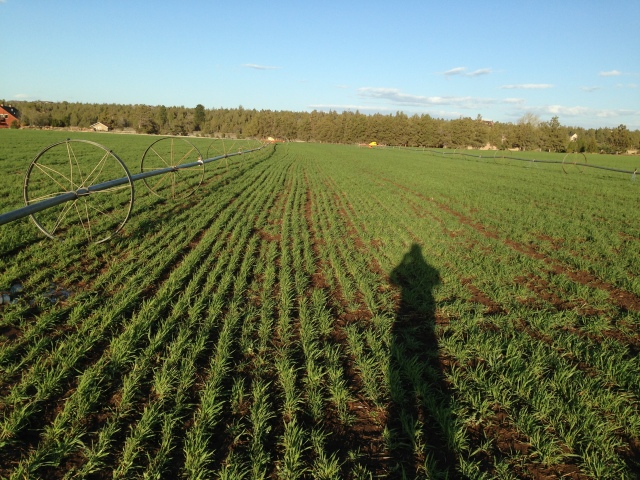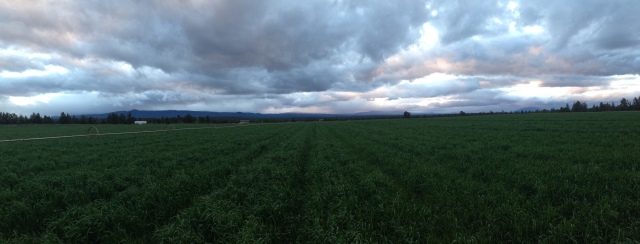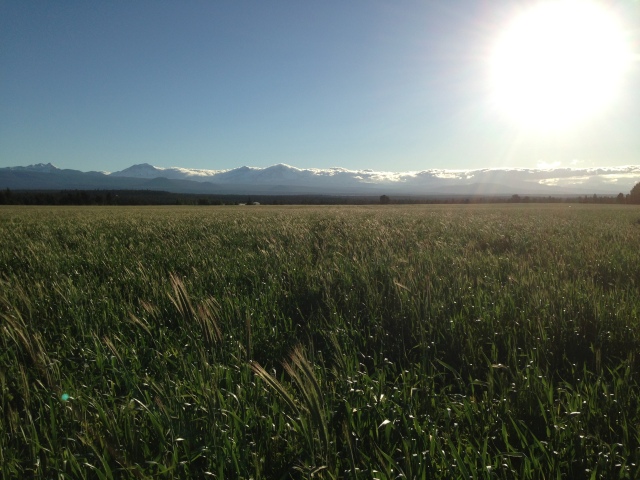Hello everyone,
I have not written a new post in a few months as I ran out of inspiration and got real busy with a new school year and wrapping up the 2014 farming season. However I have done quite a bit of research and gone to some cool places to learn about soil health, and what Central Oregon farmers (and other farmers in other areas) can do to build their soil health.
Soil health and the living biology in our soil is becoming a huge focus in today’s agriculture. Seems like the focus is shifting away from genetic potential of plants and using genetics to create higher yielding crops, back to the soil these crops are grown in. I have been very interested in soil biology and created healthy soil ever since I took a soil class last fall at Oregon State University as part of my Agriculture Science degree.
Central Oregon hay farmers are removing almost 100% of the crop residue grown annually on their land. That is the business of hay, we grow feed that can be conveniently stored and shipped to other livestock producers while not losing much of the nutritional value of the feed. This has been done for hundreds of years, but the distance the crop is travelling off the farm it was grown has climbed so much that the nutrients will not be recycled back into the soil from that crop. Farmers have tried to solve this nutrient mining by adding synthetic fertilizers, and they do a great job of adding back nitrogen, phosphorus, potassium, and other micro nutrients removed, but they do nothing to build soil biology or structure.
Soil serves as a growing medium for plant life, and the managing of soil should be high on the list of a successful farmer. Soil is used a storage medium for water and nutrients, as well as an environment for bacteria and animals, most of which are on the farmer’s side! Our high desert soils are often very course and sandy, with poor water holding capacity and often rather low on nutrients. In fact, before irrigation and fertilizers, the land supported very little biomass growth and was quite barren! Therefor farmers are at a disadvantage to farmers that are in areas where the environment created soils with higher water holding capacity and balanced with clay and organic matter contents. However we can do something about some of our soil’s poor characteristics through one tool that is often disregarded in our area.
Manure. Manure is a great resource. I want to discuss a bit about the side to manure you might not have thought much about but I think could be a huge asset in our area. Manure contains N,P,K, and trace minerals, the amount it is claimed to have of each of the elements differs based on the literature source as well as the animals it came from. One can easily calculate what a ton of manure is worth based on the current fertilizer prices. This article from Purdue is a good tool in calculating what your manure is worth and how to correctly handle and apply it. I find that the cost of hauling manure from a source is pretty high compared to it’s fertilizer value. However it has other benefits than as a fertilizer.
Manure builds soil organic matter. Organic matter is comprised of plant residues and living bacterial biomass, as well as humus (the final product of plant decomposition). Organic matter adds to soil fertility in a couple of ways:
- It increases the soil’s nutrient holding capacity (increasing the cation exchange capacity). This allows more nutrients to bind with the soil particles, which will eventually be released and used in plants. The higher the exchange cation capacity, the higher the amount of positively charged particles that nutrient particles can bind to. Nothing adds to the cation exchange capacity number more than organic matter.
- Manure increases the water holding capacity of the soil. Sandy soils, such as soils in Central Oregon, are large particles and therefor has weakens the surface tension power in water. Sandy soils absorb water much quicker than clay type soils, but also releases it and allows it to travel down the soil profile much quicker. Increasing organic matter content through manure allows our soil to hold more water, allowing higher irrigation efficiency, as well as reduces the leaching of water soluble nutrients such as nitrogen.
- Manure also builds soil structure. Stable soil aggregates allow for better water filtration, deeper root growth, as well as increases the nutrient holding capacity of the soil. Soil structure is destroyed by tillage, and rebuilding that structure is a great way to increase the soil health and overall yield capacity of the soil.
I have just scratched at the surface (heheh) of learning about soil health, but it is clear that adding manure to our ground can help produce better crops in the future. Manure is one way to add organic matter, cover crops can also be a great tool in building soil, but I feel that manure is a more cost effective and practical tool in our area to build our soils. Cover crops take much of our short growing season and can take many years to decompose and add value to our soil in our dry climate, and thus reduces it’s value.
My next post will explore some of the ways an operation can add manure to soils in a cost-effective manner.




